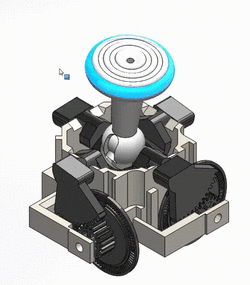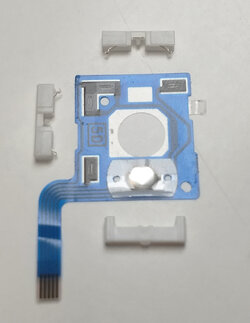I've never seen "controller drift" from wear in an N64 controller. Even 3DS: no drift. But the NS controllers I have already got it with not much use.
I can temporarily fix it by pushing the controllers down (they're also buttons) until they stops drifting, but this only helps until they drift again.
N64 uses a completely different system for inputs, its not actually analog. It uses gears with holes on a wheel to shoot an optical light through, based on the number of holes it outputs a value from 1 - 128 or whatever the cap is, on each axis. It's physically impossible for the n64 to drift, the only downside is that all that contact causes the hardware itself to wear down. N64 sticks get floppy when the plastic used grinds and turns to dust, you can alleviate this with lube, but its also pretty easy to replace the parts with metal kits available.

3ds I'm not entirely sure about, but it uses the same sort of contact adjusting resistance that standard potentiometer sticks use, just in a compact layout. If it does use graphite it probably doesn't drift due to it being held tightly together.
Holding the controller together only fixes joycon style sticks, there is a tiny bit of space between the bottom of the joystick housing and the shell of the joycon, so applying pressure pushes the pcb towards the contacts of the joystick, allowing it to push past the graphite dust that builds up and properly connect to the circuit. You can actually put a piece of card inside the joycon behind the stick to add pressure to alleviate drift, but you can also just get Hall effect joycon sticks now and those will never drift.

Joycon sticks in general are just kinda designed poorly, probably to fit in a small space. You can see the scratches on the graphite on this one. Standard potentiometers have much thicker graphite pads, and are on a solid plastic back instead of a flex pcb, so the drifting can be alleviated for much longer.

This is a standard potentiometer stick, the metal contact connects to the white piece on the left, and the graphite pad snaps on overtop, because its laid out vertically any dust would fall down, and the hard plastic and denser graphite means drifting doesn't immediately become an issue. I'm not sure if something changed since controllers are using the same ALPS sticks since the PS2/Xbox era (PS3 briefly had Hall sticks, and the Dreamcast also had Hall sticks), I don't know if the quality has decreased or if people are just playing games more and noticing the drift faster.
Hall effect sticks don't actually have any contact on anything. It uses the Hall effect which is some fancy physics thing to do with electricity and magnetic fields, basically what it means is that the stick instead of moving contacts on a graphite pad, moves a magnet, and the electrical difference when you move the stick around from a magnet below the moving magnet can be used to calculate the position of the stick with an extreme precision. The only thing that can wear out on Hall sticks is the actual spring used to snap the stick to the middle.

This is the Gulikit Hall effect stick, which was designed to fit into the profile of the ALPS sticks, but they aren't cross compatible because of different pin outs sadly. Their King Kong Pro 2 controller is actually really nice and I've been using it for a while now since my Pro controller started drifting, and replacing the stick is a pain.




